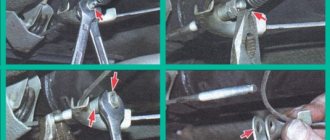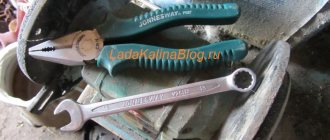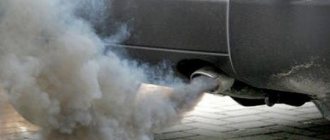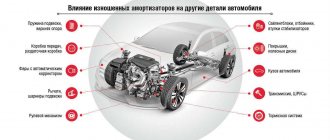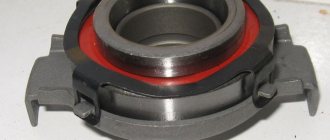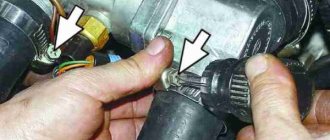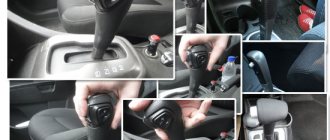In addition to the painful sensation at the fingertips, many people at this moment begin to experience an unpleasant trembling throughout their entire body.
Imagine that you are not a simple car owner, but a taxi driver. In this case, your passenger is a pensioner with a pacemaker.
Although experts assure that such a discharge is not capable of killing or causing significant harm to health, it is still not worth testing this in practice with a sick person.
Why does the car give an electric shock?
There is nothing supernatural here and everything can be explained by the laws of physics. This happens due to the accumulation of a charge of static electricity, and it is formed due to the electrification of such elements:
- car body;
- clothes;
- seat covers or upholstery.
In spring and summer, the car is electrocuted more often, since electrification occurs more intensely at low air humidity. Although such a discharge is not very pleasant, it is absolutely safe for a healthy person.
Static electricity accumulates on the car body due to its friction with the air. This usually happens while driving, but it also happens when parked under the influence of wind. When a person touches the body, for example, closing a door, the charges of the body and the body are equalized and an electric shock occurs. The reason for this may be clothing or covers. During their friction, a static charge also accumulates and the described process is repeated.
Another reason for this problem is a car malfunction. If the electrical wiring is damaged, the wires may become exposed and come into contact with metal parts of the body. The machine turns into a large capacitor and when touching its body, a person receives a noticeable electric shock.
Sparking does not cause increased voltage as long as no inductance is included in the circuit. It is dangerous when high-voltage wires, ignition coil windings and relays are exposed.
Video: why a car gives an electric shock
Solution
Most causes can be eliminated by replacing devices. This applies to the network noise filter, heating element, control board, and power button. In other cases, you can get by with repairs or installation of additional devices.
Replace heating element
Replacing the heating element with a new one solves 90% of all problems. Detailed instructions for dismantling and installation are given just above.
Residual current device (RCD)
A residual current device (RCD) is designed to protect people and other electrical equipment in the house from voltage surges and accidental current leaks.
When choosing an RCD, they are guided by:
- Mains voltage. Regular networks have 220 V, special (three-phase) - 380 V.
- Current strength. Typically, a 30 mA RCD is sufficient for domestic needs.
- The class of the device itself. For washing machines, class “A” RCDs are used.
- Availability of additional levels of protection.
Self-installation of a residual current device is only possible if you have the appropriate knowledge and skills. If you are not confident in your abilities, it is better to entrust this task to a specialist. To understand the essence of the installation, watch two videos:
Installation of a differential machine
The differential circuit breaker performs the functions of a household circuit breaker, designed to protect the home network from overloads and short circuits, and a residual current device (RCD). This is the best solution for old apartments and private houses that do not have grounding. To install a differential machine, you will need the help of a qualified specialist.
Potential equalization system
Sometimes a potential equation system can be a solution. More often it is implemented in bathrooms where a washing machine is installed that is not connected to ground. The point is to equalize the potentials between electrical appliances and metal elements such as:
- heated towel rail;
- shower cabin;
- water pipes;
- metal ventilation ducts;
- sewer drain pipe.
All metal elements are connected by copper wire and reduced to a potential equation box (PEC). It is also better to entrust the installation of such a system to a specialist.
How to check grounding integrity
The integrity of the grounding is checked with a multimeter by measuring the voltage between the phase and the body of the machine. If voltage is detected, then there is no grounding or it is damaged. In this case, it is necessary to make grounding for the “washer”, or, if this is not possible, to create a potential control system with the obligatory inclusion of an RCD or differential circuit breaker.
How to solve a problem
There are several ways to effectively deal with electric shocks when touching certain parts of the car. When an electric shock occurs when you touch the external parts of the machine, for example, handles, body and others, then to eliminate the problem you must perform the following steps:
- visit the service station. Recommended in case of frequent and strong shocks of static electricity that occur due to electrical wiring faults. There they will carry out diagnostics, identify and eliminate the cause. If you have enough knowledge and time, you can independently check the serviceability of all wires;
- install antistatic strips. You just need to purchase them at any auto store and attach them to the rear bumper.
When an electric shock occurs when you touch the internal elements of the car, for example, the steering wheel, gear lever and others, then you must do the following:
- pay attention to the interior trim. The simplest solution would be to buy seat covers. They must be antistatic; if the interior is leather, then such problems do not arise;
- adjust your wardrobe. Try not to wear things made of fabrics that accumulate static electricity (wool, silk, natural fur, synthetics);
- if you don’t want to change your wardrobe, use special sprays to treat upholstery and clothing. They help minimize the chance of electricity buildup;
To minimize the risk of electric shock when getting out of your car, first touch any metal part with your hand before opening the doors and standing on the ground.
Video: what to do if the car is electrocuted
When a problem such as an electric shock occurs when touching a car, it is imperative to find the cause and eliminate it. It may seem like a small thing to some people, but it is very unpleasant for children, and in some cases, a spark that appears can even lead to a car fire.
What else do you need to know?
If none of the above helps and the vehicle continues to shock its owner, remember the rules for getting out of the car.
After opening the door, you should touch the metal part of the vehicle with your foot and only then step on the ground. This will help relieve accumulated static voltage and increase the safety of using the vehicle.
Another feature is to regularly clean the interior of additional sprayed substances. This preserves the health of the driver and passenger and protects them from gasoline vapors and other flammable substances. The safety of using a vehicle should be first and foremost.
Antistatic strips are recommended to be changed regularly in accordance with operating requirements.
Important! Some vehicle owners prefer to save money and not buy additional protective equipment. This is an undesirable strategy; the owner pays for small savings in security.
Static electricity and the car
Everyone knows the effect of combing hair with a plastic comb. When the hair “stands on end.”
Or when taking off synthetic clothing, a slight cracking occurs. And if you do this in complete darkness, then small sparks-discharges will even be visible. The same thing happens inside the car with people.
Why does the car give an electric shock? There are many reasons for this. Let's try to identify the most common ones:
- Sometimes the person himself is indirectly to blame for this situation. The fact is that during movement, clothing rubs against the seat upholstery. The person himself begins to accumulate static electricity. This often happens if clothing contains natural wool or synthetic fibers. Without suspecting it, when leaving the vehicle, he hits the door or body and a discharge occurs. Answer to the question: “Why do you get electric shock when you get out of the car?” becomes obvious. It's partly our own fault.
- The car itself begins to accumulate a static charge. This can happen in different ways.
1. The car body receives an electric shock because during the trip the car moves in space and comes into contact with the air. Charge accumulates on it. The longer the movement time, the more accumulation occurs. Dry weather also helps increase the charge.
Of course, the person sitting inside tends to have electrical potential. The whole question is what significance does its charge have. If it's the same as the vehicle, then no one will feel anything. If there is a plus and a minus, then upon contact a discharge will occur.
2. In another case, when the car door is electrocuted, there is another reason. This is a machine malfunction. Due to various circumstances, its electrical wiring may be damaged. Under the influence of friction or chafing, or falling out of the fixing devices, they begin to rub against body parts. And the insulation in this place is destroyed.
The exposed section of the wire begins to come into contact with the body iron. A so-called “breakdown to ground” occurs. The machine begins to resemble a capacitor of appropriate dimensions and with a fairly strong capacity. And when the driver or passenger gets out and grabs the door or handle, they receive an electric shock.
Watch a useful video on how to detect a current leak on a VAZ 21102:
A trifle, a trifle?! No matter how it is!
Although at first glance it may seem that static discharge will not cause much harm, it is worth considering this problem more seriously. When the body of the machine receives an electric current, a micro-discharge occurs. A good example, but of a different nature, is a piezo lighter.
What if, for some reason, there are vapors of gasoline or other flammable substances in the cabin? This micro-lightning can ignite them, and the consequences can be the most tragic.
The question: “the machine is electrocuted - what to do?” should be resolved immediately.
There is one more important circumstance to this. While driving, the driver constantly performs a number of important functions - this is his job. Controls the car, turns on and off various functional devices - windshield wiper blades, direction indicators, side lights, high and low beam toggle switches.
Constantly changes gears if the car has a manual gearbox. And if at this time a shock of static electricity occurs, then from surprise it may well not be able to cope with control. With all the ensuing consequences.
Electrical appliances
Some readers are probably interested in the question: what to do if an electrical discharge passes in close proximity to the vehicle’s electrical appliances. Despite the insignificant impact force, under unfavorable circumstances the devices may fail.
First of all, this applies to automotive devices. A sprayed aerosol increases air humidity, improves well-being and protects devices from accidental failure.
At first glance, the loss of a device is not as bad as the ignition of a flammable substance sprayed into the air. However, disruption of the correct operation of the vehicle device leads to unpleasant situations, including a possible loss of control over the vehicle.
Important! Get regular maintenance. According to independent studies, this reduces the risk of emergency situations when driving a vehicle and significantly reduces the risk of road accidents.
The main causes of electric shocks from the car body
There are several options for storing charge on the driver or on the car. Let us say right away that the version popular on the Internet that the charge is gained from air friction on the car body is false. This theory states that the dirtier your car, the more static charge it will pick up as you drive. Most likely, the myth was invented by some car wash owner, since the degree of contamination of the car does not in any way affect the build-up of static charge.
The real reasons that can cause such a charge to accumulate and subsequently be released onto your fingers are quite simple. And it won’t be difficult to eliminate them either. Typically, car owners face the following problems in this case:
- the driver's clothes rub against synthetic covers, a static charge appears on the driver;
- the electrical system in the car is faulty, there are breakdowns in the body that cause static current discharges;
- there is no discharge of static energy using antistatic tapes and other tools.
To start
IMPORTANT! We recommend eliminating any breakdown immediately, even if the current “pinches” imperceptibly: over time, you risk receiving a severe or even fatal shock.
Turn off the power to the equipment
At the first breakdown, turn off the machine by removing the plug from the socket. Pressing the “turn off” button is not enough: the “washing machine” will remain connected to the 220 volt network.
As a last resort, it is necessary to de-energize the entire room with an automatic switch (circuit breaker) on the distribution brush in the apartment or in the entrance. And only then unplug the plug from the socket.
This option is used in special cases when there is no access to a machine:
- flooding;
- water pipe break in the bathroom or kitchen;
- the force of the breakdowns became life-threatening.
Prepare your tools or call a professional
After disconnecting the machine from the network, decide what to do: solve the problem yourself or call a specialist. The first option assumes that you have at least basic skills in repairing electrical appliances.
At a minimum you will need a set of tools:
- Screwdriver Set;
- wrenches, including pipe wrenches;
- set of hexagons;
- indicator screwdriver;
- multimeter;
- fabric or polyvinyl chloride based electrical tape.
As for the other option, it is enough to find the nearest home appliance repair service to you and call a specialist to your home. Sometimes it is necessary to transport equipment to the workshop.
How to properly install an antistatic device in a car?
The first option for protecting against electric shock in a car is a regular antistatic agent that needs to be sprayed on the seats and clothing. By doing this, you will reduce the likelihood of charge accumulating directly on the driver or passengers. If this does not help, you should move on to the next steps.
It would also be a good idea to check the car's electrical system. A charge can be given to the engine by faulty spark plugs, which spark directly onto the engine body, as well as broken high-voltage wires. It is worth keeping the engine itself clean, because the charge can be transferred through a layer of adhering liquid. But the main method of getting rid of static shock in a car is to organize the following protection options:
- special antistatic tapes to remove static charge from the body;
- for large cars with an increased risk of fire or explosion, antistatic chains made of metal that conduct current well are used;
- sometimes a ground wire is used as an antistatic agent, which is attached with a terminal to the body, and the second edge is cut off, allowing the wires to drag along the ground.
Of course, the most convenient option is to use antistatic rubber strips, which are attached to the rear of the car and do not spoil the appearance. But their production requires expensive conductive rubber. This makes the cost of the tapes quite high, which is why there are a huge number of fakes on the market. To avoid such counterfeits, choose expensive rubber antistatic tapes from well-known manufacturers.
Many drivers buy rubber bands with wire inside. This way out of the situation helps to get rid of static charges only for a certain time, because the wire quickly rusts or oxidizes and ceases to perform its functions. It is also important that the tape is not screwed to the bumper, but rather to a metal part of the body. In this case, the paint at the fastening site must be stripped down to metal.
True, there are tips in the “life hack” style from Internet users, as in the following video:
Additional Information
The accumulation of static electricity cannot be considered a dangerous phenomenon if properly protected from it. In regions with high air humidity, this danger can be almost completely neglected. Static electricity hardly accumulates and the problems associated with it disappear.
The same applies to cases of rare use of the vehicle. The car moves little, electricity does not accumulate and the risk of an accident is significantly reduced.
However, it is still better to use additional means to protect against the accumulation of electricity. This is equally true for a car and for a person.
For example, if the driver prefers to wear shoes with rubber soles, it is recommended to use antistatic insoles for grounding. Don't forgo other safety enhancements.
Let's sum it up
You can remove the unpleasant effect of static current discharges from your car with your own hands, without spending a lot of time and money on it. It is important to ensure that the vehicle's electrical system is fully operational and then ensure that the accumulated energy is dissipated through antistatic tapes. To do this, you need to purchase high-quality devices that will actually discharge the charge, and not just drag along the asphalt behind the car.
By applying all the above tips, you can forget about the fact that the machine is electrocuted. Have you had similar situations in your life, and how did you solve a similar problem?
What should you not do?
There are a number of tips that not only will not give the desired result when a washing machine pinches a person, but can also cause real harm, namely:
- If there is no grounding, inverting the plug in the socket has no practical significance, since the washing machine operates on AC power and changing the polarity does not change anything for it;
- Laying a rubber mat near the washing machine does not solve the problem, since the potential does not go away, and a person can be hit when he touches the washing machine and the wall, battery, etc. with his hand;
- Disabling the surge protector - this element of the washing machine does supply potential to the body, but in normal mode the voltage is safe and should not be felt;
Figure 4: Connecting the surge protector to the chassis - Grounding the body of the washing machine to the heating system creates a threat not only to the residents of the apartment, but also to the entire riser; grounding can only be done using a special conductor.
Serving fruit on the holiday table
The festive table is usually set not only for family members, but also for invited guests.
A festive feast will be considered a success if the table is beautifully and correctly set, and the guests at the table are comfortable and comfortable.
There are several rules for setting a festive table, following which any hostess will be able to show her ability to welcome guests at the highest level:
- The tablecloth for the festive table should be perfectly clean and ironed. It is advisable to spread a thick cloth on the table under the tablecloth, which will prevent the dishes from clanking if they accidentally fall, and will also protect the table surface from spilled liquids. However, it is permissible not to cover the table with expensive wood at all.
- Dishes and cutlery used for serving must be from the same set. It is unacceptable to serve the holiday table with dishes of different colors and sizes. The cleanliness and shine of dishes must be impeccable.
- Both plates and cutlery should be laid out only in the order in which the hostess plans to serve the dishes.
- There should be no unnecessary dishes and cutlery on the table. Items “just in case” are not needed, but will only spoil the appearance of the table.
- All alcoholic drinks are served in pre-opened bottles, but champagne is opened immediately before serving.
- One cloth and several paper napkins should be prepared for each guest.
- The hostess pours the first course into plates from the tureen for the guests. One of the guests or household members can help her serve filled plates. This must be done by approaching everyone present at the table from the right side.
- Guests put the second dish on their own plate from the common dish.
The presence of thematic decor in the center of the festive table will emphasize the efforts of the hostess and give the feast coziness and warmth.
Beautiful festive table setting
Before you start serving the table with fruit, you need to prepare small, sharp knives for slicing. It would be a good idea to stock up on tools that allow you to cut out shaped elements.
You can place fruit slices on a plate in different forms. The most commonly used silhouettes are the firebird, butterfly, and tower. The children's dish is laid out in the shape of some fairy-tale hero. For an anniversary, you can mark a significant date with fruits. Table setting at home, photos of which are presented below, will tell you options for decorating fruit slices.
